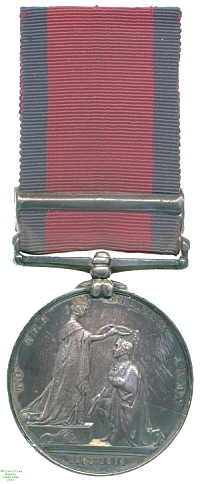
Obverse, a bust of Queen Victoria facing left

Reverse, Queen Victoria on dais placing a wreath on the head of the kneeling Duke of Wellington

Obverse, a bust of Queen Victoria facing left |

Reverse, Queen Victoria on dais placing a wreath on the head of the kneeling Duke of Wellington |
It had been unusual, before the reign of Queen Victoria, for medals to be issued recognising service in campaigns (except perhaps those organised by the East India Company). This left, for example, veterans of the Napoleonic Wars with nothing to display for their service, and therefore three medals were instituted in 1847-1848 for campaigns of the previous fifty years, in the East India Company's forces, in the Royal Navy or in the Army, the last of which was the Military General Service Medal, instituted in 1847 and first struck in 1848.
The intentions of the medal committee are hard to divine, as the medal was struck carrying the dates `1793-1814' in the reverse, but the earliest campaign considered was that in Egypt from 1798 to 1801. Earlier battles may have been deleted from consideration due to the shortage of surviving veterans of engagements of the previous century. This was one of the paradoxes shared by all three of the General Service Medals, another being that the monarch whose portrait they bore, Queen Victoria, was not him for whom the recipients had fought.
The MGSM, given the period that it covered, was mainly awarded for campaigns of the Napoleonic Wars, which on land had mostly been fought in the Iberian Peninsula. For this reason the medal is often called the `Peninsular Medal' even though it also covered campaigns in Egypt, Java and America.
The Peninsular War arose from Emperor Napoleon I of France combining with Spain to occupy ports on the western coast of Portugal, in order to break the British naval blockade of France in 1807, which he followed in 1808 by a military takeover of Spain. Spanish resistance forces administered several defeats to occupying French forces, however, and this and a concomitant Portuguese uprising persuaded Britain to commit land forces against Napoleon for the first time in some years, under Sir Arthur Wellesley, the later Duke of Wellington (who is seen on the reverse of the MGSM).
By 1813, despite victories for both sides in the field and despite repeated fractures of the shaky co-operation between British and Spanish forces, the combined Spanish and Anglo-Portuguese forces, now all under Wellesley's leadership and immeasurably aided by a huge Spanish guerilla campaign behind the French lines, had driven the French, under Maréchal Soult, back as far as the Pyrenees. The Allied advance crossed into France in October 1813. The last two battles of the Peninsular Campaign were fought between Wellesley and Soult at Orthez, and at Toulouse, where Soult, defending the city against an Allied siege and bombardment, received the unhappy news of Napoleon's surrender. He reluctantly followed suit, having inflicted 4,500 casualties on the Allies for 3,000 in his own ranks.
This medal was awarded to Private J. Richardson of the Royal Artillery, who was presumably one of those bombarding Toulouse under Wellesley. Lester Watson purchased his medal at some point before 1928.